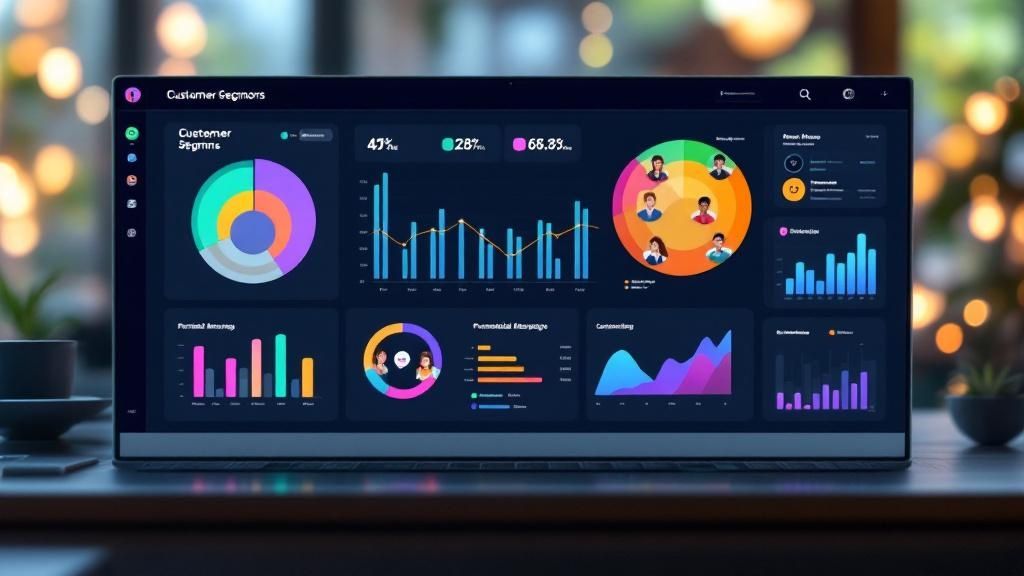In today's hyper-competitive landscape, intuition alone is no longer enough to win. The most successful B2B and consumer brands are moving beyond traditional marketing, harnessing the power of data to make smarter, faster, and more impactful decisions. This shift from assumption to insight is the core of data-driven marketing, a strategic approach that uses customer information and market analytics to optimize performance and drive measurable growth. But how do you translate raw data into actionable strategies that move the needle?
This article cuts through the noise to provide a roundup of the most effective data-driven marketing strategies for your business. We will explore practical techniques, from advanced personalization to predictive forecasting, that empower you to connect with your audience on a deeper level, maximize your ROI, and build a sustainable competitive advantage. Forget vague theories; this guide is designed for action.
You will learn how to implement specific tactics that transform your marketing efforts into a powerful growth engine. We'll cover everything from customer lifetime value (CLV) optimization and dynamic pricing to advanced attribution modeling and real-time marketing automation. Whether you're a seasoned expert at a professional services firm or a B2B SaaS leader just beginning to integrate data into your workflow, these strategies provide a clear roadmap for achieving tangible results.
1. Customer Segmentation and Personalization
At its core, customer segmentation involves dividing your broad customer base into smaller, more manageable groups based on shared characteristics. This foundational element of data-driven marketing strategies moves beyond one-size-fits-all messaging to deliver tailored experiences. By analyzing data points like demographics, purchase history, online behavior, and geographic location, you can craft messages that resonate deeply with each specific subset of your audience.

This approach transforms raw data into meaningful connections. The result is not just better marketing but a more relevant customer journey, which directly boosts engagement, loyalty, and conversion rates.
Why It’s a Powerful Strategy
Segmentation and personalization are powerful because they address a fundamental consumer expectation: relevance. When a marketing message speaks directly to a customer's needs or past interactions, it cuts through the noise. For instance, Amazon's recommendation engine, a prime example of behavioral segmentation, is responsible for an estimated 35% of its revenue. Similarly, Netflix's hyper-personalized content suggestions drive over 80% of all content watched on the platform. These giants prove that understanding customer segments isn't just a tactic; it's a significant revenue driver.
How to Implement It
Getting started doesn't require an Amazon-sized budget. You can begin with basic segmentation and evolve your approach over time.
- Start with Foundational Data: Group customers based on accessible data like industry (for B2B), job title, or geographic location. For B2C, this might be age, location, or past purchase categories.
- Layer in Behavioral Insights: As you mature, integrate behavioral data. Track website pages visited, content downloaded, and email engagement. This allows for more dynamic and accurate segmentation.
- Leverage Progressive Profiling: Instead of overwhelming new leads with long forms, gather information over time. Ask for a job title on the first interaction, company size on the second, and so on.
- Test and Validate: Use A/B testing to confirm your personalization efforts are working. Test a personalized email subject line against a generic one to measure the uplift in performance.
For a deeper exploration of this topic, you can learn more about effective customer segmentation strategies on twelverays.agency.
2. Predictive Analytics and Forecasting
Predictive analytics moves beyond analyzing past events to forecast future outcomes. This advanced data-driven marketing strategy uses historical data, statistical algorithms, and machine learning techniques to identify the likelihood of future results. It empowers marketers to anticipate customer needs, identify potential churn risks, and optimize campaign spending by making proactive, data-informed decisions instead of reactive ones.

By leveraging predictive models, you can transform your marketing from a series of educated guesses into a calculated, forward-looking engine for growth. This approach helps allocate resources more effectively and ensures marketing efforts are targeted at the most promising opportunities.
Why It’s a Powerful Strategy
The power of predictive analytics lies in its ability to answer the critical question: "What is likely to happen next?" For instance, Netflix famously uses predictive algorithms to forecast a show's potential success, influencing its multi-billion dollar content investments. In the B2B world, companies use lead scoring models to predict which prospects are most likely to convert, allowing sales teams to focus their efforts where they will have the most impact. This foresight provides a significant competitive advantage, reducing waste and maximizing ROI.
How to Implement It
Implementing predictive analytics is more accessible than ever, thanks to modern tools and a methodical approach.
- Ensure Data Quality: Your predictions are only as good as your data. Start by cleaning and consolidating your data sources to ensure they are complete, accurate, and relevant.
- Start with Simple Models: You don't need a complex AI to begin. Start with simpler predictive models, such as identifying customers likely to churn based on recent activity or predicting which leads are ready for a sales conversation.
- Combine Data Sources: For more accurate predictions, integrate multiple data sources. Combine CRM data with website analytics and email engagement metrics to build a more comprehensive view.
- Validate and Update: Predictive models are not "set it and forget it." Regularly test their accuracy against actual outcomes and update them with new data to ensure they remain relevant and effective.
3. Attribution Modeling
Attribution modeling is a framework for analyzing which touchpoints in the customer journey deserve credit for a conversion. Instead of giving all the glory to the final click, this powerful data-driven marketing strategy helps you understand the true impact of each channel, from the first blog post a lead reads to the final ad they click. It enables marketers to allocate budgets more intelligently and optimize the entire marketing funnel.
This concept map illustrates how different multi-touch attribution models assign value across the customer journey. By moving beyond a single-touchpoint view, these models provide a more holistic understanding of how various marketing efforts contribute to success.
Why It’s a Powerful Strategy
Relying on last-click attribution is like giving a film's Best Picture award only to the final scene. It ignores the crucial setup and character development that made the ending possible. Attribution modeling corrects this by providing a comprehensive view of what truly drives results. For example, Google's data-driven attribution model can improve advertiser ROI by revealing the hidden value of upper-funnel activities. Similarly, B2B platforms use attribution to help users prove marketing's contribution to revenue, sometimes increasing qualified leads by over 25%.
How to Implement It
Implementing attribution doesn't have to be overly complex from day one. You can build sophistication as your data capabilities grow.
- Ensure Solid Tracking: First, confirm that your tracking (like UTM parameters and conversion pixels) is consistently implemented across all digital touchpoints.
- Start with Simple Models: Begin by comparing basic models available in platforms like Google Analytics. Look at First-Click to understand what initiates the journey, and Last-Click to see what closes it. This initial comparison often reveals valuable insights.
- Graduate to Multi-Touch Models: As you advance, explore multi-touch models like Linear (even credit to all touchpoints) or Time-Decay (more credit to recent touchpoints). This offers a more balanced view of your channel performance.
- Regularly Review and Adapt: Your marketing strategy and customer behavior will change. Revisit your attribution model quarterly to ensure it still aligns with your business goals and the evolving customer journey.
4. Real-Time Marketing Automation
Real-time marketing automation is a dynamic strategy that uses immediate customer data to trigger personalized marketing actions. This approach moves beyond scheduled campaigns, allowing brands to respond instantly to customer behaviors like website visits, cart abandonments, or content downloads. It’s a core component of modern data-driven marketing strategies, enabling you to deliver the right message at the exact moment it’s most relevant.

This instantaneous response system creates highly contextual and timely experiences. By leveraging platforms like HubSpot or Salesforce Marketing Cloud, you can automate these interactions to boost engagement, accelerate the sales cycle, and increase conversion rates.
Why It’s a Powerful Strategy
The power of real-time automation lies in its ability to capitalize on customer intent in the moment. When a user abandons a shopping cart, an immediate, automated email with a small discount can recover the sale. This timeliness is what sets it apart. For instance, Sephora’s Beauty Insider program uses real-time purchase data to trigger personalized product recommendations and exclusive offers, significantly increasing customer lifetime value. Similarly, Spotify’s ability to update playlists instantly based on listening behavior keeps users deeply engaged, demonstrating the immense power of real-time responsiveness.
How to Implement It
Implementing real-time automation can be scaled from simple triggers to sophisticated, multi-channel workflows.
- Start with Simple Triggers: Begin with foundational trigger-based campaigns. Common examples include sending a welcome email series to new subscribers, a cart abandonment reminder, or a follow-up after a content download.
- Ensure Data Integration: Your automation is only as good as your data. Ensure your systems, like your CRM and website analytics, are integrated to allow for a seamless, real-time flow of information.
- Test and Refine Workflows: Before launching a campaign to your entire audience, thoroughly test every step of the automation. Send test emails, fill out forms, and confirm that triggers and subsequent actions work as expected.
- Maintain Human Oversight: While automation is efficient, don't completely remove the human element. Monitor campaign performance and maintain human oversight for critical interactions, especially in B2B sales where a personal touch is key.
For a comprehensive guide, you can explore the nuances of a successful marketing automation implementation on twelverays.agency.
5. Customer Lifetime Value (CLV) Optimization
Customer Lifetime Value (CLV) optimization is a forward-looking strategy that shifts the marketing focus from short-term gains to the long-term profitability of each customer relationship. It involves using predictive analytics and historical data to forecast the total revenue a business can expect from a customer over their entire journey. This powerful metric helps marketers make smarter decisions about where to invest their resources for maximum return.
By understanding CLV, you can identify your most valuable customers, optimize acquisition spending to attract similar high-value prospects, and tailor retention efforts to keep your best clients engaged. This approach ensures your data-driven marketing strategies are not just generating leads but are building a sustainable and profitable customer base.
Why It’s a Powerful Strategy
CLV optimization is powerful because it aligns marketing efforts directly with profitability. Instead of treating all customers equally, it allows you to allocate resources proportionally to their value. For example, Adobe’s transition to a subscription model was a masterclass in CLV optimization. Similarly, Amazon Prime’s membership strategy is designed to boost engagement and repeat purchases, driving its average member CLV far beyond that of non-members. These examples show that focusing on CLV is a direct path to enhancing long-term business health.
How to Implement It
Implementing a CLV-focused approach means integrating this metric into your core marketing and business decisions. You can start by building a foundational model and refining it over time.
- Calculate CLV with Multiple Metrics: Move beyond simple purchase history. Incorporate metrics like purchase frequency, average order value, and customer lifespan. For more advanced models, factor in operational costs and referral value.
- Segment Customers by CLV: Group your customers into tiers based on their CLV (e.g., high-value, mid-value, low-value). This allows you to create tailored marketing campaigns, loyalty rewards, and customer service protocols for each segment.
- Focus on Customer Success: High CLV is a direct result of high satisfaction and retention. Invest in customer success initiatives and proactive support to ensure customers are getting the most from your products or services.
- Launch Targeted Win-Back Campaigns: Identify high-CLV customers who have churned and create personalized win-back campaigns to re-engage them. The potential return from reactivating these accounts is often much higher than acquiring a new customer.
To discover more about keeping your most valuable customers, you can explore proven customer retention strategies on twelverays.agency.
6. Behavioral Targeting and Retargeting
Behavioral targeting is a potent data-driven marketing strategy that involves tracking and analyzing user actions across digital platforms. This approach moves beyond simple demographics to focus on what users do: the pages they visit, the content they engage with, and their purchase history. By understanding these behavioral signals, you can deliver highly relevant ads and content that align with a user’s demonstrated interests, making your marketing feel more like helpful suggestions than interruptions.
This strategy is split into two core functions: targeting, which finds new audiences based on their online behaviors, and retargeting (or remarketing), which specifically re-engages users who have already interacted with your brand. Both are crucial for guiding potential customers through the sales funnel.
Why It’s a Powerful Strategy
Behavioral targeting is effective because it is based on explicit user intent, not assumptions. When you show an ad for a product to someone who just viewed it on your website, you are meeting them exactly where their interest is highest. The results speak for themselves: Google's retargeting campaigns can generate conversion rates up to 10 times higher than standard display ads. Similarly, Meta's behavioral targeting capabilities have helped advertisers achieve significantly higher click-through rates by reaching users who exhibit specific purchasing behaviors.
How to Implement It
You can integrate behavioral targeting into your campaigns using popular advertising platforms and a systematic approach.
- Implement Tracking Pixels: Start by placing tracking pixels (like the Meta Pixel or Google Ads tag) on your website. This is the technical foundation that collects the necessary behavioral data.
- Segment Your Audience by Action: Create distinct audience lists based on specific behaviors. For example, segment users who visited a pricing page, abandoned a shopping cart, or downloaded a specific whitepaper.
- Set Frequency Caps: To prevent ad fatigue, set a limit on how many times a single user will see your retargeting ad within a specific period.
- Use Exclusion Lists: Be strategic about who you target. Exclude users who have already converted (e.g., made a purchase) from that specific campaign to avoid wasting ad spend and irritating new customers.
- Test Retargeting Windows: Experiment with the time frame for retargeting. A user who visited yesterday is a hotter lead than one who visited 90 days ago. Test different windows, like 7, 14, or 30 days, to find the optimal timing for your sales cycle.
7. A/B Testing and Multivariate Optimization
At its core, A/B testing is a controlled experiment where two or more variants of a single marketing asset are shown to different audience segments to determine which one performs better. Multivariate optimization takes this a step further by testing multiple variable changes simultaneously. This is one of the most direct data-driven marketing strategies, as it replaces guesswork with hard statistical evidence about what truly drives user action.
This methodical approach allows marketers to refine every element of their campaigns, from email subject lines and ad copy to landing page layouts and calls-to-action. By isolating variables and measuring their impact on key metrics like click-through rates or sales, you can make incremental improvements that compound into significant gains over time.
Why It’s a Powerful Strategy
This strategy is powerful because it provides definitive, actionable answers. Instead of debating which headline is best, you can let your audience’s behavior provide the answer. The impact is well-documented; for example, Booking.com famously runs thousands of tests simultaneously to optimize its user experience. Similarly, political campaigns have used A/B testing on email subject lines and website designs to raise hundreds of millions in additional donations. These examples show that optimization is a direct path to achieving business objectives.
How to Implement It
A successful testing program involves a systematic process, not random changes. You can start small and scale your efforts as you build momentum.
- Start with a Hypothesis: Begin by identifying a problem (e.g., low landing page conversions) and forming a hypothesis. For example, "Changing the CTA button color from blue to orange will increase clicks because it creates higher contrast."
- Isolate One Variable: In classic A/B testing, test only one element at a time (e.g., the headline or the button color, not both). This ensures you can attribute any change in performance directly to that specific variable.
- Ensure Statistical Significance: Use a large enough sample size and run the test for an adequate duration to ensure your results are not due to random chance. Many A/B testing tools have built-in calculators for this.
- Document and Iterate: Meticulously record the results of every test, including both successes and failures. These learnings are invaluable for informing future hypotheses and building a smarter marketing program.
8. Cross-Channel Data Integration
Cross-channel data integration is the strategy of consolidating customer information from all marketing channels into a single, unified view. Modern customers interact with brands across a scattered landscape: website, social media, email, mobile apps, and physical stores. This strategy breaks down the data silos between these channels, providing a holistic understanding of customer behavior.
By weaving together these disparate data threads, you can map the complete customer journey. This enables you to deliver consistent, coordinated, and highly relevant experiences, no matter how a customer chooses to engage with your brand. It’s a cornerstone of sophisticated data-driven marketing strategies that foster seamless customer interactions.
Why It’s a Powerful Strategy
This strategy is powerful because it mirrors how customers interact with businesses today: fluidly and across multiple platforms. A disconnected experience is jarring and can lead to lost sales. For instance, Sephora’s Beauty Insider program masterfully integrates online, mobile, and in-store data. A customer can add items to their cart on the mobile app and then receive personalized recommendations from a store associate who can access their purchase history. This unified approach enhances the customer experience and significantly increases loyalty and lifetime value.
How to Implement It
Implementing a fully integrated system is a journey, but you can start with strategic, incremental steps to build a unified customer view.
- Prioritize High-Impact Channels: Begin by integrating your most critical channels first, such as your website, CRM, and email marketing platform. These often hold the richest customer data.
- Invest in a Customer Data Platform (CDP): A CDP is designed specifically for this purpose. Platforms like Salesforce Customer 360 or Segment act as a central hub to collect, clean, and unify customer data from various sources in real-time.
- Establish Data Governance: Create clear policies for how data is collected, stored, and managed across the organization. This ensures data consistency and reliability, which is essential for accurate insights.
- Ensure Real-Time Synchronization: For a truly seamless experience, data must be synchronized in real-time. This allows you to react instantly to customer actions, such as sending a follow-up email moments after they visit a specific product page.
For a comprehensive guide on unifying customer data, you can learn more about implementing a Customer Data Platform from Segment.
9. Dynamic Pricing and Revenue Optimization
Dynamic pricing is an advanced data-driven marketing strategy where prices for products or services are adjusted in real-time based on fluctuating market factors. Instead of a fixed price, this approach uses algorithms to analyze demand, competitor pricing, inventory levels, and customer behavior. The goal is to maximize revenue by finding the optimal price point at any given moment.
This strategy moves pricing from a static, quarterly decision to a dynamic, automated process. By leveraging data analytics and machine learning, businesses can respond instantly to market shifts, ensuring they remain competitive while capturing the maximum value from every transaction.
Why It’s a Powerful Strategy
Dynamic pricing is powerful because it directly aligns price with perceived value and market demand in real-time. This agility can lead to significant revenue gains. The airline industry has long used dynamic pricing to optimize revenue, and Uber's surge pricing effectively balances driver supply with rider demand.
Perhaps the most famous practitioner is Amazon, whose algorithms reputedly change millions of prices every day. This constant optimization helps them maintain a competitive edge and maximize profitability on a massive scale, demonstrating how integral data-driven pricing is to modern e-commerce success.
How to Implement It
Implementing a dynamic pricing model requires careful planning and a phased approach to manage risk and maintain customer trust.
- Set Clear Boundaries: Before launching, establish clear pricing rules and boundaries. Define minimum and maximum price points to prevent extreme fluctuations that could damage brand perception or alienate customers.
- Start Small and Test: Begin with a limited set of low-risk products. This allows you to test your algorithms and analyze the impact on sales and customer behavior in a controlled environment.
- Monitor Customer Perception: Keep a close watch on customer feedback. Abrupt or seemingly unfair price changes can lead to backlash. Transparency is key to maintaining trust.
- Use A/B Testing: Validate your pricing strategies by running A/B tests. Compare the performance of a dynamic pricing model against a static price for a specific customer segment to measure its direct impact on revenue.
10. Social Listening and Sentiment Analysis
Social listening involves monitoring digital channels like social media, forums, and review sites to understand what is being said about your brand, competitors, and industry. Paired with sentiment analysis, which uses AI to determine the emotional tone behind the conversations, this becomes one of the most proactive data-driven marketing strategies available. It transforms unstructured public chatter into a clear picture of brand perception and market trends.
By systematically analyzing this data, you can move beyond reactive responses and start anticipating customer needs, identifying product gaps, and spotting emerging opportunities. This strategy allows you to tap directly into the authentic, unfiltered voice of the customer.
Why It’s a Powerful Strategy
This strategy is powerful because it provides real-time, unbiased feedback at scale. While a customer survey captures a single point in time, social listening offers a continuous stream of insights. For example, Domino's Pizza famously used insights from social listening to completely overhaul its pizza recipe and marketing, leading to a massive turnaround in brand perception and sales. Similarly, Netflix analyzes social buzz around certain genres or actors to inform its content acquisition decisions.
This direct line to consumer sentiment helps you manage brand reputation proactively, refine messaging, and even inspire product innovation.
How to Implement It
You can start integrating social listening into your marketing efforts without a massive initial investment.
- Define Clear Monitoring Parameters: Start by identifying key terms to track. This includes your brand name, product names, key personnel, campaign hashtags, and competitor names.
- Combine Automation with Human Insight: Use tools like Brandwatch or Sprout Social to automate data collection and initial sentiment analysis. However, always have a human analyst review the context, as AI can misinterpret sarcasm.
- Set Up Real-Time Alerts: Configure your tools to send alerts for significant shifts in sentiment, spikes in mention volume, or mentions from influential accounts. This enables rapid response during a PR crisis or a viral opportunity.
- Focus on Actionable Insights: Don't get lost in vanity metrics like the raw number of mentions. Instead, focus on insights that can drive decisions. What are the most common customer complaints? What features are users requesting?
- Integrate with Other Data Sources: Combine social listening data with insights from your CRM and customer support tickets. This creates a holistic view of the customer experience and helps validate trends you observe on social channels.
Data-Driven Marketing Strategies Comparison
From Data to Decisions: Your Path to Marketing Excellence
We've explored ten powerful, data-driven marketing strategies, each offering a distinct path to transform raw information into remarkable results. From the granular precision of behavioral retargeting to the forward-looking power of predictive analytics, the message is clear: the future of marketing isn't about guesswork; it's about making calculated, evidence-backed decisions. The days of launching campaigns into the void and hoping for the best are over. Success in today's landscape is directly tied to your ability to harness, interpret, and act on data.
The strategies discussed, such as advanced customer segmentation, dynamic pricing, and attribution modeling, are not isolated tactics. They are interconnected components of a holistic marketing engine. Integrating data across channels breaks down silos, creating a unified view of the customer journey. This single source of truth then fuels more accurate A/B testing, more relevant real-time automation, and a deeper understanding of Customer Lifetime Value (CLV). It's a virtuous cycle where each strategy strengthens the others, compounding your ROI and building sustainable growth.
Key Takeaways for Immediate Action
Embracing this new paradigm can feel overwhelming, but progress is built on incremental, intentional steps. The most successful data-driven marketing strategies are those that are adopted thoughtfully and scaled over time.
To move from theory to practice, consider these foundational principles:
- Prioritize with Purpose: Re-evaluate your primary business objectives. Are you focused on lead acquisition? Customer retention? Increasing deal size? Select the one or two strategies from this list that most directly impact your immediate goals. For example, a firm struggling with lead quality should focus on attribution modeling and behavioral targeting first.
- Embrace a Culture of Testing: Data-driven marketing demands a commitment to continuous optimization. Make A/B testing a standard procedure for everything from email subject lines to landing page headlines. Cultivate a mindset where insights, not opinions, guide your next move.
- Invest in the Right Tools and Talent: Effective data analysis requires a combination of sophisticated technology and skilled interpretation. Your CRM, marketing automation platform, and analytics dashboards are the bedrock of your efforts. Ensure they are properly integrated and that your team, or a trusted partner, has the expertise to translate complex datasets into clear, actionable insights.
Your Path Forward: Building a Data-First Foundation
The journey toward marketing excellence is iterative. It begins with a commitment to moving beyond vanity metrics and focusing on the data that truly drives revenue and customer loyalty. Start by auditing your current data sources. What information are you collecting, and more importantly, what are you doing with it? Identify the low-hanging fruit—a single campaign or customer segment where you can apply one of these strategies and measure the impact.
The ultimate goal of any data-driven marketing strategy is not just to gather data, but to turn that data into a dialogue. It's about understanding your customer so deeply that you can anticipate their needs and deliver value before they even ask for it.
By implementing these sophisticated data-driven marketing strategies, you are not just optimizing campaigns; you are building a more resilient, intelligent, and customer-centric organization. You are creating a competitive advantage that is difficult to replicate, one rooted in a deep understanding of your market and a disciplined approach to execution. This transformation empowers your team to make smarter decisions, allocate resources more effectively, and ultimately, deliver the kind of personalized experiences that build lasting relationships and fuel long-term growth.
Ready to turn your complex data streams into a clear roadmap for growth? The team at Twelverays specializes in implementing the advanced data-driven marketing strategies your business needs to thrive. We help professional services firms and B2B companies integrate their technology, analyze their data, and execute campaigns that deliver measurable results. Contact Twelverays today to unlock the full potential of your marketing data.
Related Data & Analytics Resources
Data-driven marketing success requires the right tools, processes, and strategic thinking. Explore these complementary resources to enhance your analytics capabilities:
- Marketing Attribution - Understand which channels drive the best ROI
- Customer Data Integration - Unify your customer data for better insights
- Database Management Best Practices - Maintain clean, actionable data
- Customer Experience Measurement - Track and optimize customer satisfaction
By implementing these data and analytics strategies alongside your marketing efforts, you'll create a comprehensive measurement framework that drives continuous improvement and growth.





